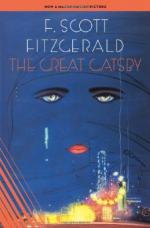|
This section contains 1,366 words (approx. 5 pages at 300 words per page) |

|
Bleakness and Futility in Chapter 2 of "The Great Gatsby"
Juxtaposed to the starry-eyed end of Chapter 1, the `crumbling' and `desolate' image of the valley of ashes projects the bleakness and futility of the inner recesses of 1920s Jazz Age society. It embodies the spiritually hollow nature of the society as something eventually to implode and to collapse into the insubstantiality of its underpinning. The bonds of the hedonistic revelry of the opening chapter find metaphorical dismemberment in the contradictory gloominess of chapter 2; they collapse like the fabric of the American dream.
Fitzgerald manages to evoke the spiritual insolvency of the valley through the glaring imagery of the `spasms of dust' and the `foul river', generating a world built furtively and inescapably by the hands of the faceless `ash-grey men' screened by `the impenetrable cloud'...
|
This section contains 1,366 words (approx. 5 pages at 300 words per page) |

|


